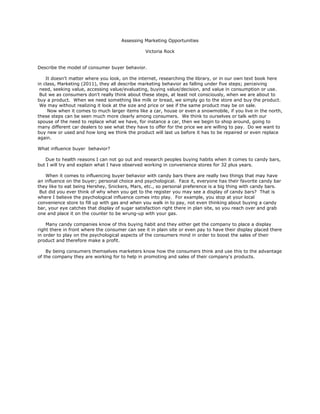Assessing marketing opportunities
- 1. Assessing Marketing Opportunities Victoria Rock Describe the model of consumer buyer behavior. It doesn't matter where you look, on the internet, researching the library, or in our own text book here in class, Marketing (2011), they all describe marketing behavior as falling under five steps; perceiving need, seeking value, accessing value/evaluating, buying value/decision, and value in consumption or use. But we as consumers don't really think about these steps, at least not consciously, when we are about to buy a product. When we need something like milk or bread, we simply go to the store and buy the product. We may without realizing it look at the size and price or see if the same product may be on sale. Now when it comes to much larger items like a car, house or even a snowmobile, if you live in the north, these steps can be seen much more clearly among consumers. We think to ourselves or talk with our spouse of the need to replace what we have, for instance a car, then we begin to shop around, going to many different car dealers to see what they have to offer for the price we are willing to pay. Do we want to buy new or used and how long we think the product will last us before it has to be repaired or even replace again. What influence buyer behavior? Due to health reasons I can not go out and research peoples buying habits when it comes to candy bars, but I will try and explain what I have observed working in convenience stores for 32 plus years. When it comes to influencing buyer behavior with candy bars there are really two things that may have an influence on the buyer; personal choice and psychological. Face it, everyone has their favorite candy bar they like to eat being Hershey, Snickers, Mars, etc., so personal preference is a big thing with candy bars. But did you ever think of why when you get to the register you may see a display of candy bars? That is where I believe the psychological influence comes into play. For example, you stop at your local convenience store to fill up with gas and when you walk in to pay, not even thinking about buying a candy bar, your eye catches that display of sugar satisfaction right there in plan site, so you reach over and grab one and place it on the counter to be wrung-up with your gas. Many candy companies know of this buying habit and they either get the company to place a display right there in front where the consumer can see it in plain site or even pay to have their display placed there in order to play on the psychological aspects of the consumers mind in order to boost the sales of their product and therefore make a profit. By being consumers themselves marketers know how the consumers think and use this to the advantage of the company they are working for to help in promoting and sales of their company's products.

